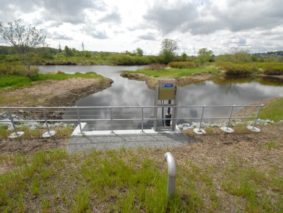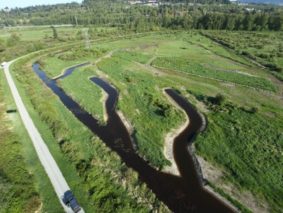
Wilson Farm Habitat Enhancement Project

Project Info
Port Coquitlam, BC
Project Services
Water Resources
Award of Excellence, ACEC-BC (2013)
National Sustainability Award, Transportation Association of Canada (2012)
Project Highlights
For the first time in 100 years, salmon are swimming in the channels at Wilson Farm. In the early 1900s, the Coquitlam River estuary was diked and drained for farming, isolating the floodplain and depriving salmon of valuable habitat.
The Wilson Farm Habitat Enhancement Project, located within Metro Vancouver’s Colony Farm Regional Park, encompasses 178,000 m2 of aquatic and riparian habitat enhancement for fish and wildlife. It was undertaken by Transportation Investment Corporation to provide environmental compensation for the Port Mann Highway 1 infrastructure improvement project.
The goals for Wilson Farm were to re-establish the tidal connection and fish access to the floodplain channels, improve drainage for wildlife habitat, and minimize disturbance to park users. The project includes a self-regulated tide gate and overshot gate, new channels and ponds, enhancements to existing channels, pump station upgrades, and riparian plantings. As part of a multidisciplinary team, Kerr Wood Leidal completed hydraulic modelling of habitat channels and prepared the detailed engineering design for the tide gates, overshot gate, and channels.
Tide Gate System
Tidal flows into the floodplain channels from the Coquitlam River were restored using a system of innovative self-regulating tide gates, and an overshot gate. The tide gate system enables full tidal exchange and easy fish passage thus restoring habitat while at the same time providing a simple, low-maintenance means of flood protection.
Pond and channel enhancements focused on providing new rearing/overwintering habitat for juvenile salmonids. To limit disturbance and preserve large areas of old-field wildlife habitat, channel improvements are primarily located in existing drainage ditches near the perimeter of existing old field habitat areas. New features include a groundwater channel for year-round salmon rearing and shallow field swales which function both to improve field drainage as well as provide food source areas for fish.
Project Development
Following approval in principle from Metro Vancouver in 2009, Transportation Investment Corporation led the design and implementation process, working with park staff, First Nations, stewardship groups and DFO. The planning and design process involved stakeholder involvement throughout the design process and provided important input to developing design concepts and addressing stakeholder concerns. The majority of channel and riparian habitat construction was carried out in summer of 2011 with some works to finalize the project planned in summer 2012.
The tide gates were opened in November 2011. In 2012, biologists found young coho, chum, pink and chinook salmon in abundance in the reconnected channels. The project is a success from a fisheries and wildlife perspective and has enhanced a valuable recreational and wildlife viewing area for area residents.
Awards
This project won the Transportation Association of Canada’s 2012 National Sustainability Award and the Association of Consulting Engineering Companies – BC’s 2013 Award of Engineering Excellence.










